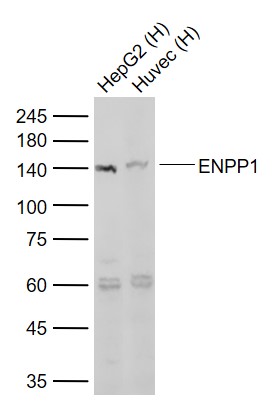
IHC-P analysis of human liver using GTX89508 ENPP1 antibody, C-term. Antigen retrieval : Tris/EDTA buffer pH 9 Dilution : 2microg/ml
ENPP1 antibody, C-term
GTX89508
ApplicationsWestern Blot, ImmunoHistoChemistry, ImmunoHistoChemistry Paraffin
Product group Antibodies
ReactivityHuman
TargetENPP1
Overview
- SupplierGeneTex
- Product NameENPP1 antibody, C-term
- Delivery Days Customer9
- Application Supplier NoteIHC-P: 2-4microg/ml. *Optimal dilutions/concentrations should be determined by the researcher.Not tested in other applications.
- ApplicationsWestern Blot, ImmunoHistoChemistry, ImmunoHistoChemistry Paraffin
- CertificationResearch Use Only
- ClonalityPolyclonal
- Concentration0.50 mg/ml
- ConjugateUnconjugated
- Gene ID5167
- Target nameENPP1
- Target descriptionectonucleotide pyrophosphatase/phosphodiesterase 1
- Target synonymsARHR2, COLED, M6S1, NPP1, NPPS, PC-1, PCA1, PDNP1, ectonucleotide pyrophosphatase/phosphodiesterase family member 1, E-NPP 1, Ly-41 antigen, NPPase, alkaline phosphodiesterase 1, alkaline phosphodiesterase I, membrane component, chromosome 6, surface marker 1, nucleotide diphosphatase, nucleotide pyrophosphatase, phosphodiesterase I/nucleotide pyrophosphatase 1, plasma-cell membrane glycoprotein 1, plasma-cell membrane glycoprotein PC-1
- HostGoat
- IsotypeIgG
- Protein IDP22413
- Protein NameEctonucleotide pyrophosphatase/phosphodiesterase family member 1
- Scientific DescriptionThis gene is a member of the ecto-nucleotide pyrophosphatase/phosphodiesterase (ENPP) family. The encoded protein is a type II transmembrane glycoprotein comprising two identical disulfide-bonded subunits. This protein has broad specificity and cleaves a variety of substrates, including phosphodiester bonds of nucleotides and nucleotide sugars and pyrophosphate bonds of nucleotides and nucleotide sugars. This protein may function to hydrolyze nucleoside 5 triphosphates to their corresponding monophosphates and may also hydrolyze diadenosine polyphosphates. Mutations in this gene have been associated with idiopathic infantile arterial calcification, ossification of the posterior longitudinal ligament of the spine (OPLL), and insulin resistance. [provided by RefSeq, Jul 2008]
- ReactivityHuman
- Storage Instruction-20°C or -80°C,2°C to 8°C
- UNSPSC12352203








